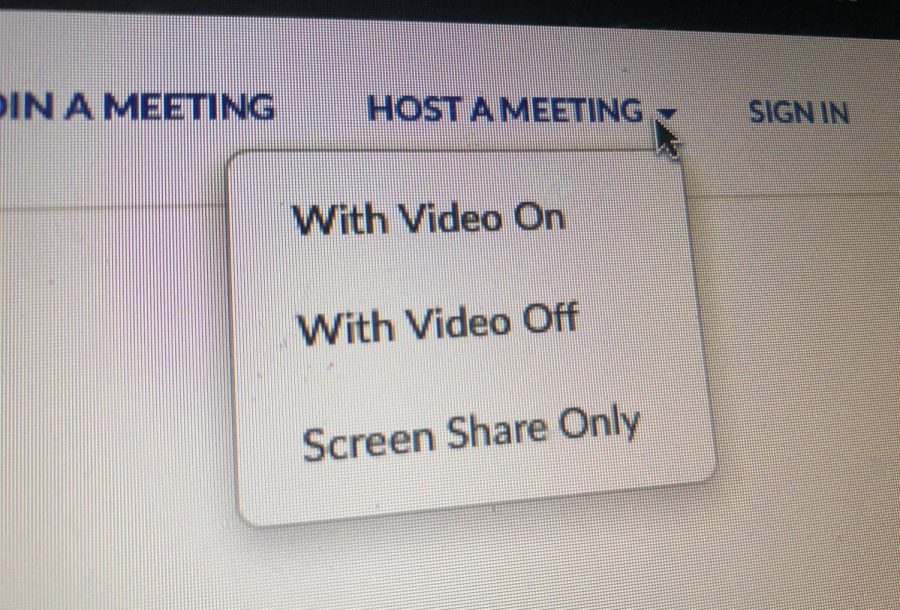The view from the front of the zoom room
Photo by Sreelikhi Vangavolu
While some teachers require their students to keep their cameras on, other teachers do not. Despite their differences in preference they all say they want what is best for their students.
In her first period class, the teacher does not require students to turn on their cameras, while in her 6th period class everyone is required to have their cameras on. Nearing almost a year of remote learning, each teacher has adapted to their own set of Zoom camera rules for each class.
While 49 percent of teachers require students’ cameras to be on sometimes and 34.9 percent of teachers never require their students’ cameras to be on (according to a Bear Facts survey of 49 teachers) all the teachers have one common goal. They all want what is best for their students, say Anne Hopkins, science teacher, and Elisabeth Slaughter, English teacher.
Camera on:
“Initially, when [my students] enter the Zoom their camera is off but they should turn it on when they enter the Zoom. So I just wait for everybody to [turn on] their camera just to make sure they’re with me,” said Hopkins. “If the student has a reason why they can’t show their face on camera, they send me a private message in [the] chat, and that’s fine, but I think everybody’s in the habit of just having that camera on when they start Zoom right away and I just wait for them [if their cameras are off].”
By having her students turn their cameras on, Hopkins can check for student activity and provide them with any help they need, she said.
“I can kind of scan the crowd and make sure they’re actively listening and participate,” Hopkins said. “[The most challenging thing about Zoom] is it’s harder to gauge student involvement, people can be shaking their heads and that sort of thing but it’s really difficult to monitor.”
Participation is very important for a science class, and zoom “takes away the in class experience needed,” but Hopkins has had no major problems with her student’s engagement, she said.
“My students are really respectful [so] I don’t have any issues, I just think [my students] know my expectations are to have the cameras on. I’ve been impressed with my students and their readiness for class. Occasionally a student will send me a chat that they’re in the car or something and they can’t have their camera on and I try to respect that. But I’ve had no issues with the cameras.”
Camera off:
On the other hand, English teacher Elisabeth Slaughter “[does] not require students to turn on their cameras.” She says she feels more comfortable allowing students to choose whether their cameras are on or off.
“I have different ways to check for student engagement, depending on what the lesson is. Personally, I felt comfortable making the call that they can do things like chat with me, or just use an emoji or turn their camera on briefly,” Slaughter said. “Another reason why is students sometimes have technical difficulties, or they’ll switch to another app and so sometimes [they can’t] turn their cameras on. So, it wouldn’t necessarily be practical for me to spend a lot of time asking students to turn their cameras on or to enforce that. I have some flexibility for those expectations.”
Like Hopkins, Slaughter believes one of the most challenging aspects of Zoom has been interacting with her students. As someone who “talks to people all day for a living,” Zoom has been a big shift, Slaughter said.
“It’s just changed the way I communicate, because a lot of times I’m feeling the temperature of the room and I can tell when students are with me. Even if 100% of cameras are on, I can’t always see all the students’ faces. I can’t see if they’re nodding or making eye contact. So that’s definitely been a challenge and it’s been a big adjustment because I’ve had to change the way I explained something, or the pace that I speak at or how often I check for understanding,” Slaughter said. “Usually I can look up and see people nodding at me [in the classroom], on Zoom I’ll have to say ‘can someone give me a thumbs up.’”
Middleground:
Despite the different approaches to having cameras on or off on Zoom, ensuring that the students are comfortable and are able to learn successfully is the most important aspect, Slaughter said.
“There are other things in teaching where a teacher will have different expectations. In terms of having a phone out for example, some teachers are fine with it, and some have pockets by their doors. So I think this is just one more area of education where we’ve realized everyone has a different style and students have to adjust to different styles and different expectations,” Slaughter said. “I think that’s a really good thing, because that diversity allows for students to use different skill sets and even just the adjustment of different styles is a good thing.”

As a senior, this is Sreelikhi's third year on staff and second year as the Spotlight Editor. She is a member of the Varsity Tennis team, a member of the...

